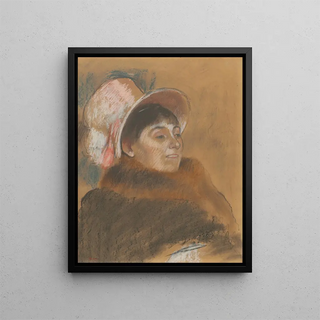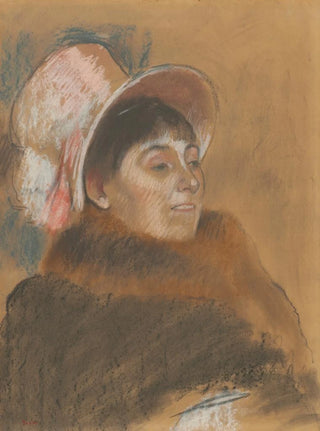Art print | Madame Dietz-Monnin - Edgar Degas


View from behind

Frame (optional)
In the vast panorama of Impressionism, Edgar Degas's "Madame Dietz-Monnin" art print stands out for its profound intimacy and subtle elegance. Created at the end of the 19th century, this painting evokes not only a frozen moment in time but also a personal story, that of the model, who was a close friend of the artist. Through this work, Degas does not merely depict a woman of high society; he captures the very essence of her personality, blending delicacy and strength. The scene, imbued with sensitivity, invites the viewer to immerse themselves in a universe where beauty and melancholy coexist, thus revealing deep and universal emotions.
Style and uniqueness of the art print
Degas's style in "Madame Dietz-Monnin" is characterized by a bold use of light and color. The artist skillfully plays with contrasts, highlighting the softness of the tones in the model's dress while emphasizing the depth of shadows. The composition, far from conventional, features a framing that feels both intimate and dynamic. True to his unique approach, Degas employs flowing lines and shapes that suggest movement, giving Madame Dietz-Monnin a certain lightness. This stylistic choice, combined with meticulous details, makes this art print a centerpiece that transcends a simple portrait to become a true psychological study.
The artist and his influence
Edgar Degas, often regarded as one of the pioneers of Impressionism, managed to leave his mark on his era with an innovative artistic vision. Born in Paris in 1834, he was influenced by the great masters of the past but also developed a style that is uniquely his own, blending realism and Impressionism. His fascination with movement, explored through his famous ballet scenes, extends also to his portraits, among which "Madame Dietz-Monnin" is a striking example. Degas captured the modernity of his time while preserving a certain nostalgia, making him an timeless artist. His influence continues to

Matte finish

View from behind

Frame (optional)
In the vast panorama of Impressionism, Edgar Degas's "Madame Dietz-Monnin" art print stands out for its profound intimacy and subtle elegance. Created at the end of the 19th century, this painting evokes not only a frozen moment in time but also a personal story, that of the model, who was a close friend of the artist. Through this work, Degas does not merely depict a woman of high society; he captures the very essence of her personality, blending delicacy and strength. The scene, imbued with sensitivity, invites the viewer to immerse themselves in a universe where beauty and melancholy coexist, thus revealing deep and universal emotions.
Style and uniqueness of the art print
Degas's style in "Madame Dietz-Monnin" is characterized by a bold use of light and color. The artist skillfully plays with contrasts, highlighting the softness of the tones in the model's dress while emphasizing the depth of shadows. The composition, far from conventional, features a framing that feels both intimate and dynamic. True to his unique approach, Degas employs flowing lines and shapes that suggest movement, giving Madame Dietz-Monnin a certain lightness. This stylistic choice, combined with meticulous details, makes this art print a centerpiece that transcends a simple portrait to become a true psychological study.
The artist and his influence
Edgar Degas, often regarded as one of the pioneers of Impressionism, managed to leave his mark on his era with an innovative artistic vision. Born in Paris in 1834, he was influenced by the great masters of the past but also developed a style that is uniquely his own, blending realism and Impressionism. His fascination with movement, explored through his famous ballet scenes, extends also to his portraits, among which "Madame Dietz-Monnin" is a striking example. Degas captured the modernity of his time while preserving a certain nostalgia, making him an timeless artist. His influence continues to






